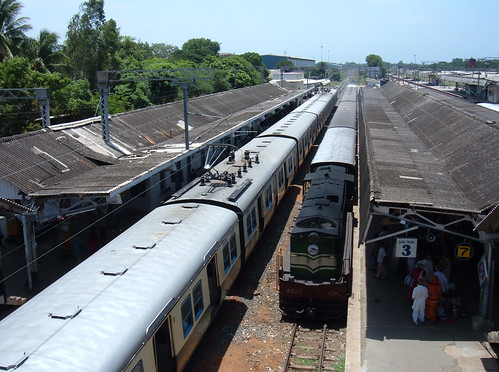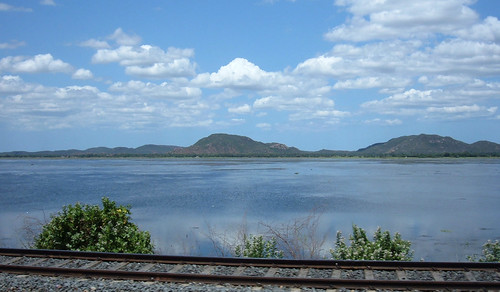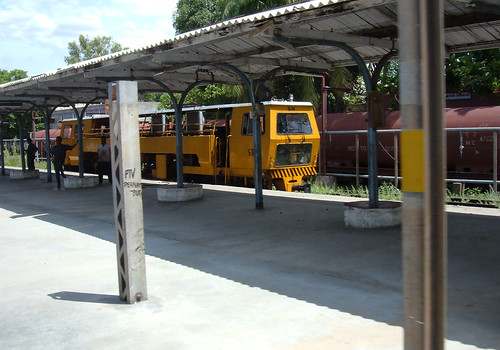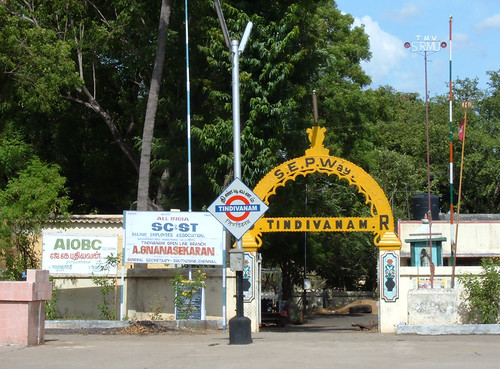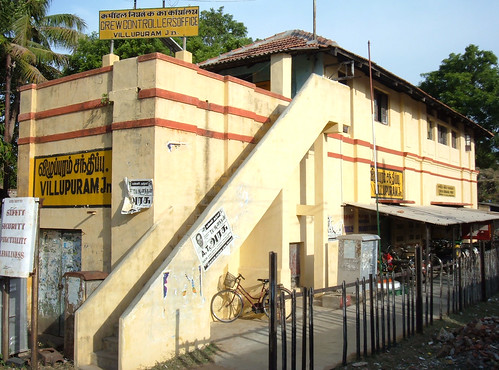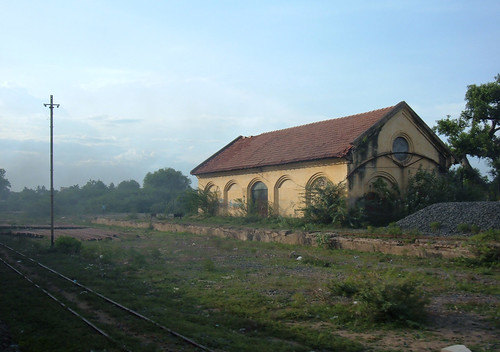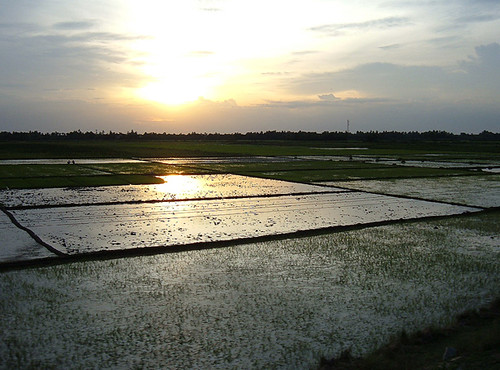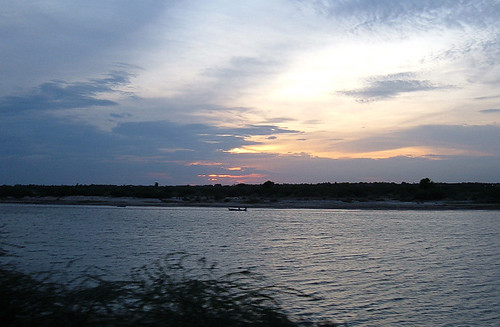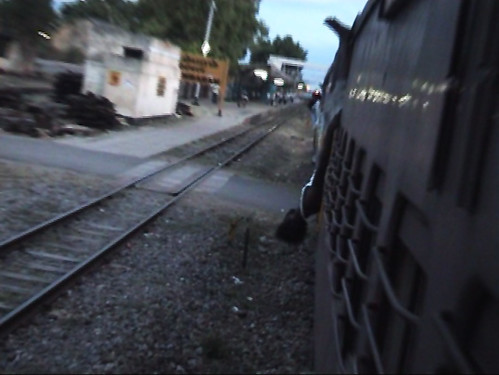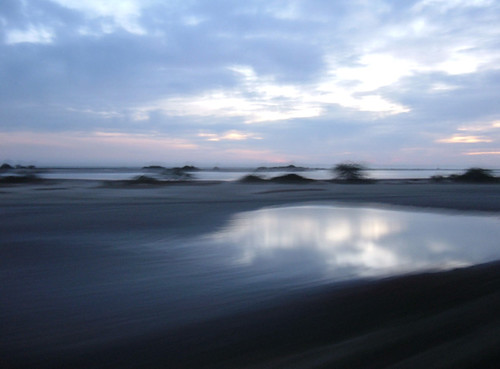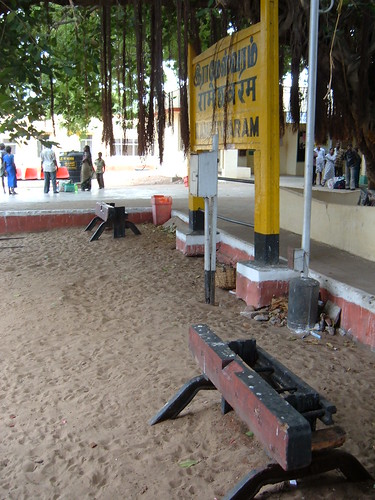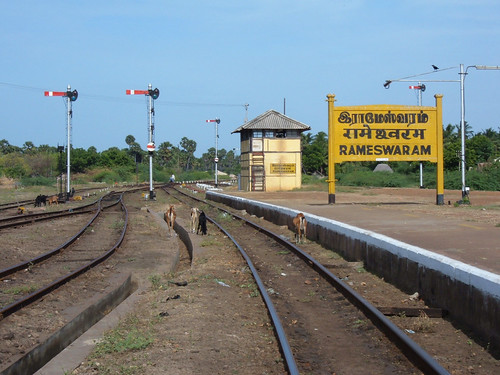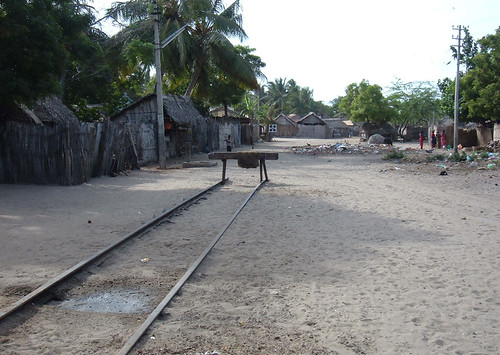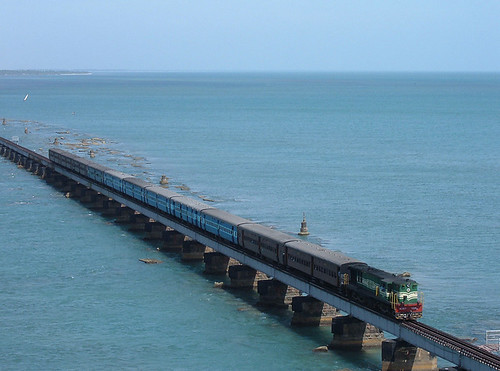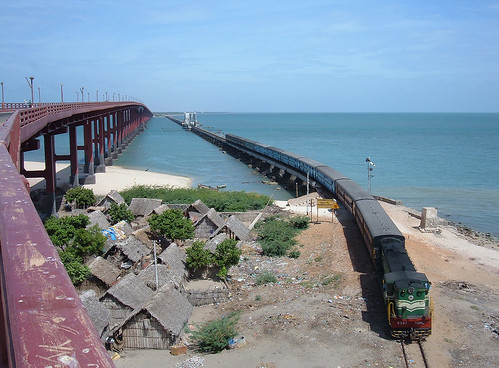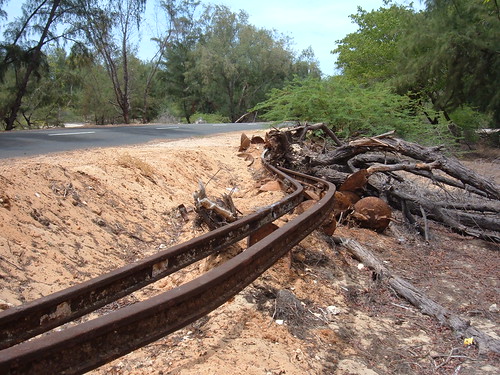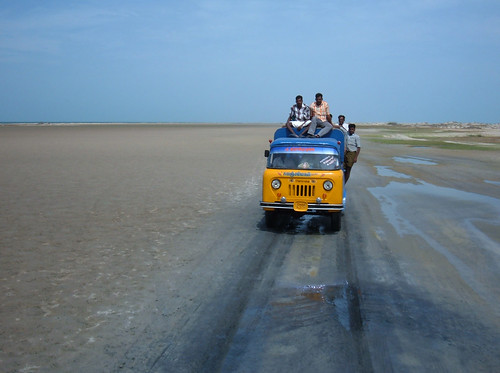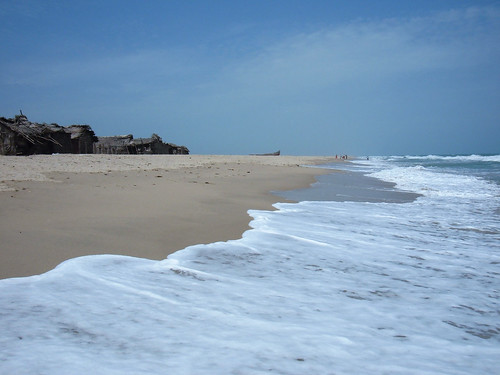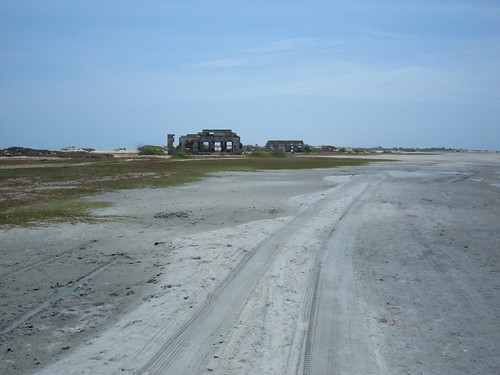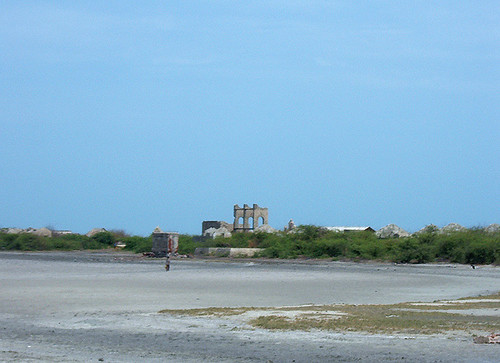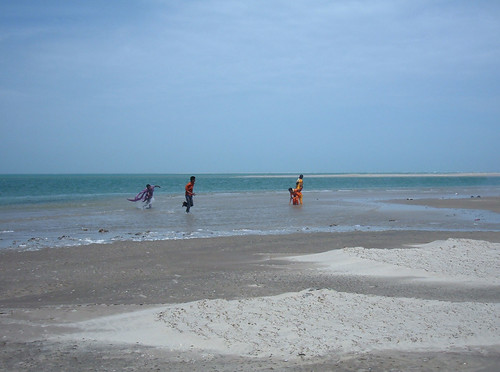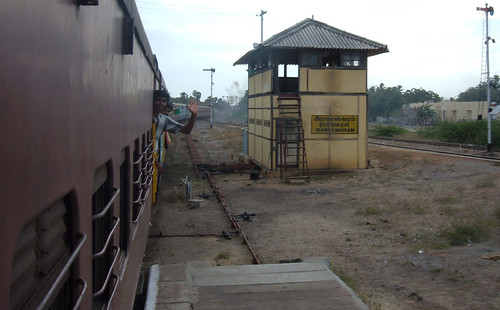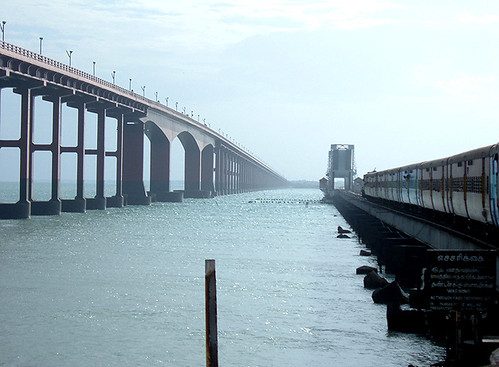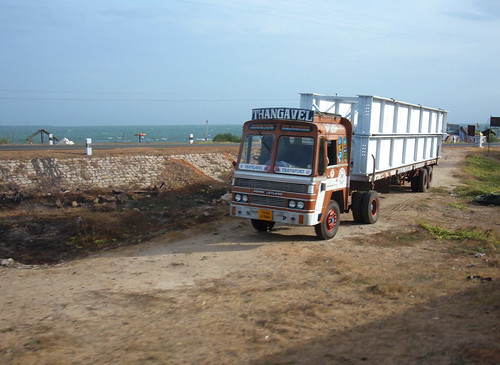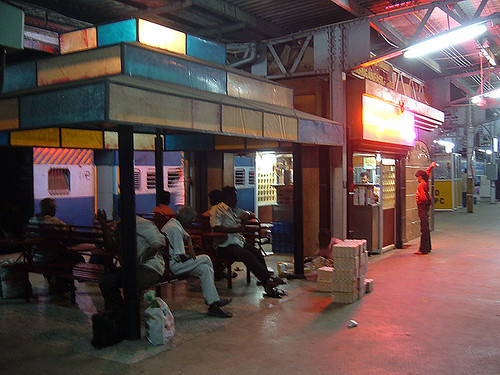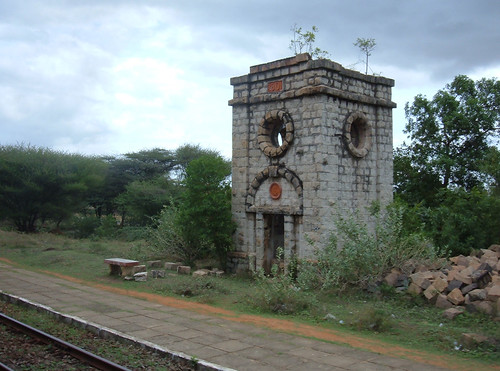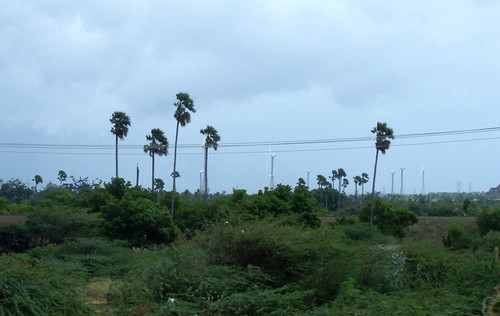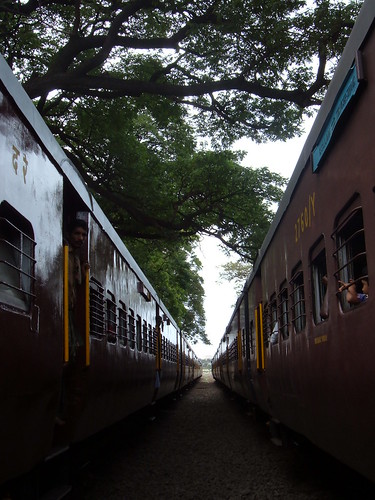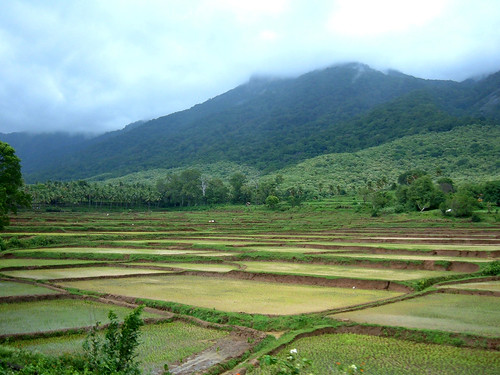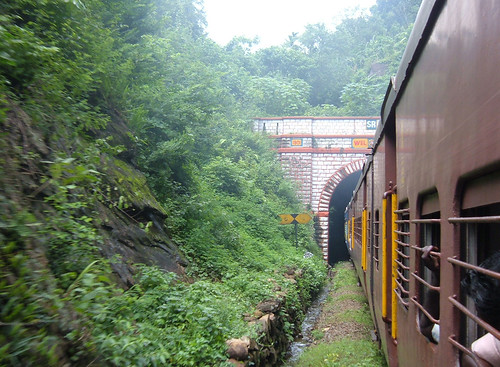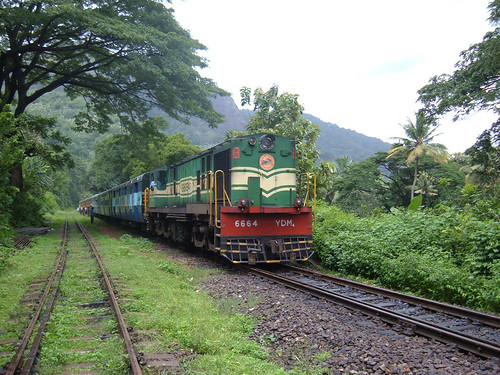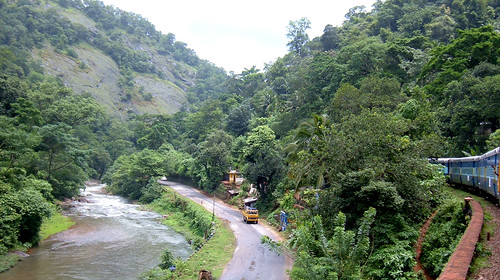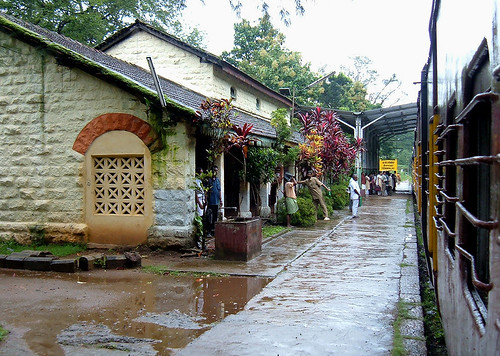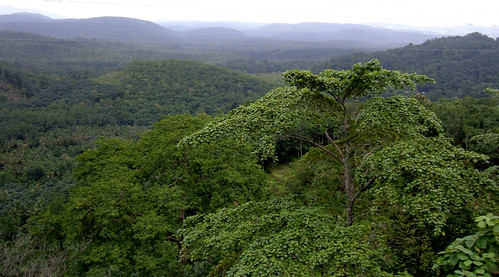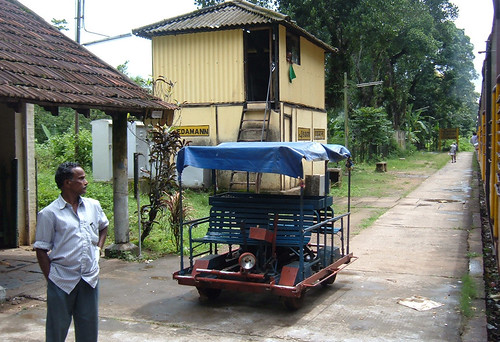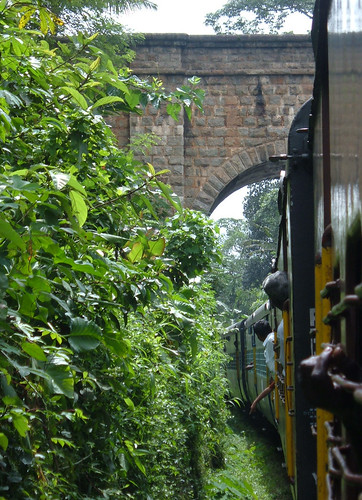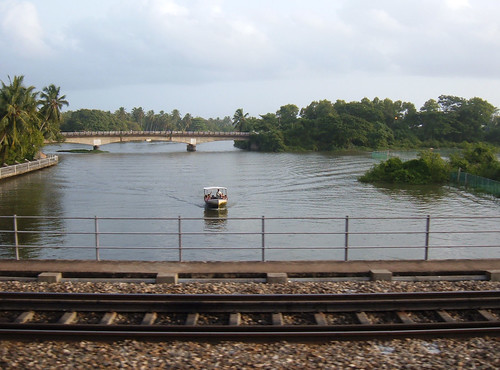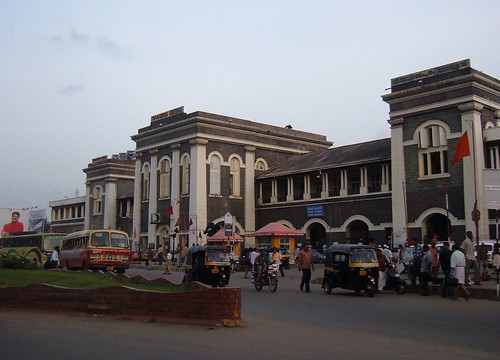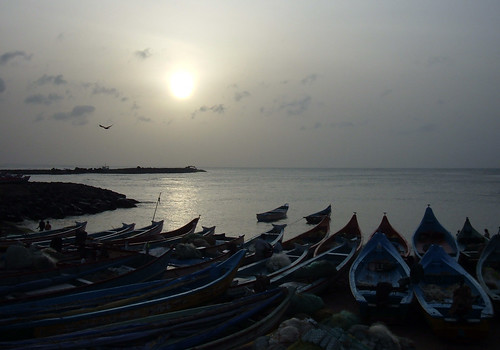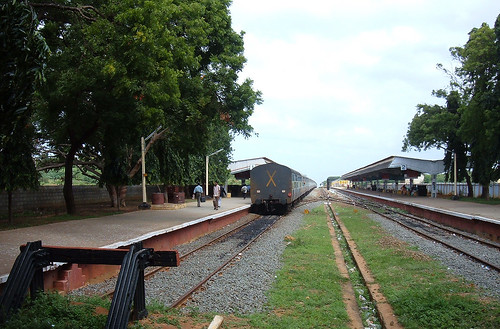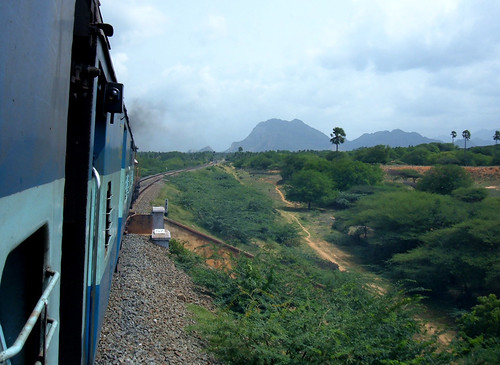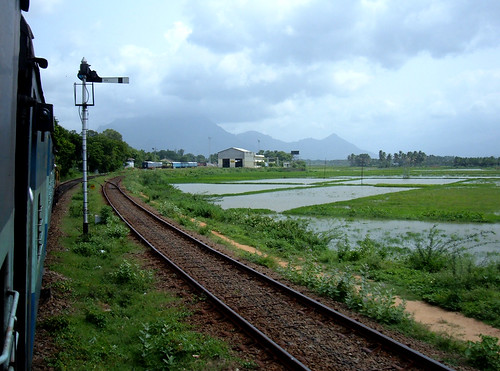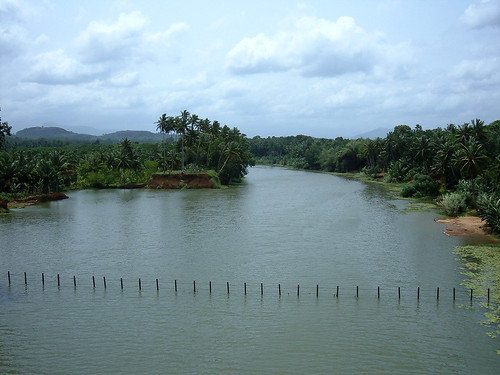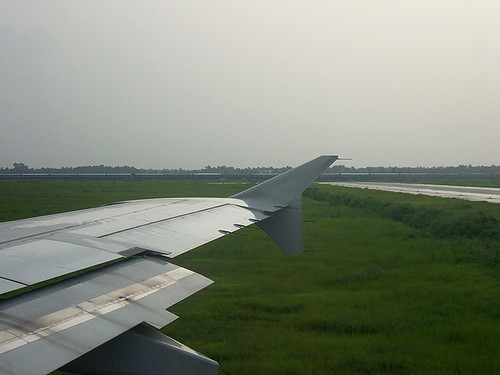Chasing the Last of Southern Metric Wonders
by Bharat Vohra
2006-07-14
Inspired by Mohan Bhuyan's classic, 'Golden Rock and Gopuram Roll', I set forth on a near identical itinerary that would enable me to experience two of SR's most storied Metre Gauge (MG) lines before they closed â€" in part or full â€" forever! And if it hadn't been for Samit's timely advice, I would have missed experiencing the first of these by only a matter of days. So after a quick advancement of my travel plans and bearing the financial damages resulting from it, I was on my way to Madras on the last flight out of Delhi on the 12th day of July '06.
Sridhar Joshi had very kindly organized a room for me at the conveniently located Metro Manor Hotel (the venue for an IRFCA convention later on) and after battling through the flooded streets of Madras in an ageing Ambi, I made it to my room at a very respectable 2 am. A few hours later, I awoke, showered, packed and made my way down to the lobby where Sridhar was already waiting, having made it to there with SR like efficiency! At the hotel restaurant, we had a thoroughly enjoyable breakfast or vadas, idlis, upma and piping hot sambar all washed down by some lovely filter coffee! The joys of the south! He walked me to Central Station thereafter and after giving me tips on what to look out for en route, bade me farewell.
After using the efficiently run cyber cafe at the station and making some long distance phone calls, I walked over to Park station to begin the first of eight train journeys I would be undertaking over the next four days. The last time I had used Park Station was to board an MG EMU (Electric Multiple Unit)four years ago. In those days Egmore had been taken over for most part by the BG but MG EMU's continued to ply through to Madras Beach. A pair of YAM1 hauled passenger trains - to Pondicherry if I'm not mistaken â€" still originated from Beach. And there was even a YDM2 parked at Egmore! But four years later, I would have to trudge south for 40 minutes on a BG EMU (Electric Multiple Unit)to get some semblance of the glorious MG era of Madras.
Beach â€" Egmore is a 3 track section while Egmore â€" Tambaram is 4 tracks. The stations along the way have a proportionate number of platforms and passenger crossings are effected not just through foot over bridges (FOB's) but also subways or underpasses â€" the first I've seen on any suburban system in India! The track quality was great and expectedly so, the ride smooth. All this coupled with minimal caution orders, hardly any line side encroachments and a negligible number of trespassers were a welcome change from the suburban sections of Bombay or Delhi. It did help matters of course that the rake I was riding in was one of those very smart, single windscreen, new ICF ones in the deep green / off white livery which seem to be ubiquitous of SR's suburban fleet today.
The emergence of Egmore as a secondary BG hub in the Madras area has led to several long distance non-daily trains terminating there. Despite it having almost 10 platforms and a well sized carriage yard, some rakes are parked at wayside stations on the route south to Tambaram (TBM). Two such train sets were spotted by me and other than that, most of the traffic encountered en route were EMU's â€" numbering 7 in all - and the sole passenger train hauled by an Arrakonam (AJJ) WAM4.
Tambaram sports possibly the largest EMU (Electric Multiple Unit)car shed I have seen in recent times and it was enough to distract me away from the MG yard to my left (east). I tried desperately to look for signs of the old MG car shed and loco shed but there were none and let alone that, I didn't even end up spotting the very rare YDM2 class. The one I had seen in Egmore some years ago was dead and I was hoping to see one in action here. I still wonder if any of them have managed to soldier on to this day.
With a little less than an hour to kill before the 1 pm departure of #6713 Sethu Exp, I made a beeline for Vasanta Bhavan â€" the nearby eatery, highly recommended by both Sridhar and Mohan. Well stocked with food, I returned to the station to survey the yard from the FOB. The 2 MG platforms were sandwiched between six BG ones, four of which served terminating EMU's and the remaining two, on the east side, used by through trains.
Activity at the station was somewhat limited at that time of day, a few arriving and departing EMU's, some YDM4s idling and a BG parcel train sans loco in one of the sidings. Notable on the MG side was an 8 wheeler tank wagon rake which I determined to be departmental. In the meantime, Golden Rock's (GOC) YDM4 6233 pulled in the 10 coach rake of the Sethu onto platform 3. It would continue to haul my train south to Villupuram.
It was fairly hot and humid that day and on any other occasion, I would have gladly booked myself on an AC coach but the lure of MG first class was too strong to resist! The added bonus of a coupe all to myself was least expected but most welcome! Built in '88 and homing to Tirupati division, WFC 5185 was to be my base for the next 18 hours or so. Other than its scruffy exteriors and some electrical fittings that were out of whack, everything else was more or less in order â€" the interiors, and most importantly, the toilets were clean. For a journey that long, that's pretty much all that mattered!
Departure was on the dot but slow progress through the turnouts quashed all hopes of racing a WAP4 hauled BG express which pulled out from TBM almost at the same time. The TBM â€" Chengalpattu (CGL) section is a 3 track corridor â€" 2 BG and the sole MG so I was hoping for some more parallel running but all I got were two crossings - an EMU, another WAP4 hauled express - and another EMU (Electric Multiple Unit)which almost caught up with us on the approach to CGL.
The route is electrified for both gauges up to Villupuram (VM) and the height of the MG masts seemed to suggest that they would continue to be used once the line was converted. That would also explain their continued existence and good appearance. The seven stations on this 30 km long suburban section sport a similar layout of 1 MG and 2-3 BG platforms and tracks corresponding in number. Being one of the oldest electrified routes in the country, colour light signaling dominates these parts.
The run up to CGL is built up and semi urban in most parts with the occasional patches of green in between. The real high point of this section is the massive sweeping curve between Paranur and CGL alongside Kolavai Lake and surrounded by low hills. I had been told to keep a vigil for this and I wasn't disappointed. Although far short of healthy water levels, it still gave one the feeling of traveling through an oasis in an otherwise urban setting.
Despite reaching a good clip of 70 km/h on the run to CGL, several caution orders ensured a much lower average of 45 but that was still enough to get us into CGL right time. A dilapidated old steam shed marks the entry to CGL yard and is the only remnant of the MG days on the east side of the station.
The present day MG station is to the west of the BG tracks and has a modest two platforms to its credit while big brother takes five. But even so, the MG side was way more interesting, sporting a tie tamping car (the first I'd seen on MG) and another rake of 8 wheeler tankers in the sidings - almost certainly ferrying water to areas where it was scarce.
While pulling out of CGL, I looked frantically for the branch line to Kanchipuram and AJJ but it was nowhere to be seen. I deemed that it had probably joined us from the west on our approach into CGL from the north. It was close to 2 pm by then and I quickly dug into my lunch of dosas and still steaming idlis! Vasanta Bhavan had, no doubt, lived up to its expectations and the gentle lurching of the MG coach clipping along at 70 added that extra zing to my meal. I had taken over my private space (read coupe) in full earnest, wasn't so bothered by the heat or humidity any more and almost oblivious of how tired and sleep deprived I was. I was slowly but surely being lulled into metric heaven!
It would be almost 3 hours till we got to VM and I sat peeled to the window to enjoy what was once one of the fastest sections on MG in India â€" where SR's `crack' trains ruled. The once double line MG section is now single BG, single MG but even today, more often than not, and surprisingly so, it's the MG that has the bigger share of stations en route - 2-3 tracks and a couple of platforms, while the BG is limited to a couple of tracks and just the single platform.
Just short of Padalam, we crossed a long bridge over the mostly dry Palar River. The landscape had been nondescript thus far but changed for the better around here. Large tracts of lush green farm land could be seen for miles on end with cattle grazing under a beautiful blue sky interspersed with clouds. Further south, these open tracts of land gave way to the more typical palm fronds and coconut plantations.
At Pakam, a MEMU (Electric Multiple Unit)train set was seen with no passengers on board and both its pantos down. I couldn't tell whether it had failed or not. One thing was for sure - the station itself certainly wasn't worthy enough of being a terminus! A few stations ahead at Olakur, there was yet another MG tanker rake and to my biggest surprise, about 3 MG EMU (Electric Multiple Unit)cars could be seen on one of the loops. They looked in fine fettle to me and it was really sad to see them lying abandoned like that at a way side station. The only plausible explanation for their presence was that they were possibly headed to Golden Rock works.
The Section Engineer (SE) at Tindivanam was obviously a proud man and the very impressive entrance to his office was a welcome relief from the drab railway structures one is used to seeing these days.
At the next station of Mailam, we had our only crossing on the section - the 15 coach MG Cholan Express, which blasted through the station behind GOC's 6034. The BG action on this section wasn't much busier â€" 2 WDM2 hauled passenger trains crossed us in quick succession and the sole freight on the line was an Erode WAG7 powered BCN set which was effortlessly overtaken by the Sethu!
At Vikravandi, two stations short of VM, we passed at least 2 MG EMU (Electric Multiple Unit)sets parked back to back on the platform loop. I tried to console myself by believing we were on one of those `crack' MG expresses overtaking an afternoon EMU (Electric Multiple Unit)service to VM. Never mind that they never ran that far in the first place!
At Villupuram north, the MG and BG mainlines swap sides, with the MG moving east and the BG aligning itself west. The lion's share of VM yard is BG today and having never been there before, I tried hard to imagine what it must have looked like in its all MG days. The elegant YAM1s of yesteryear were now replaced by a couple of beastly looking WAP4s and a boxy WAG7 giving them company. Freight traffic appeared to be moderate with only a couple of BCN sets sighted in the yard and passenger traffic seemed scarce with the sole departure of an express just as we pulled in.
On the MG side, YDM4s were everywhere â€" showing their defiance through numbers and counting out the days to their inevitable nemesis. Both bays in the trip shed were full and at least five more locos stood on a couple of layover tracks in the yard. Sadly the activity on the three MG platforms didn't quite match up to their numbers!
While reflecting on all of this over a cup of evening tea, I heard the words, `Are you Bharat Vohra from IRFCA?' For a moment I thought I had done something wrong â€" as is often the case while rail fanning â€" but on turning around I was greeted by one of IRFCA's youngest members (then) â€" S Ashwin. He happened to be traveling in the same coach as me and while scanning the reservation chart at VM, spotted my name, made the deduction and pronto, was at my window!
After watching a much delayed loco change where 6233 gave way to 6347 â€" I'm still not sure why! - Ashwin moved into my coupe for the journey south to Rameswaram.
Departure was 25" late and we manned both doors as the Sethu rolled out of VM. To our left (east) was a very handsome looking control tower which has since been converted into a crew controller's office.
Soon after that, the newly converted BG line to Pondicherry crossed us. Our alignment would bear south east towards the coast â€" turning sharply away from what was once the MG mainline to Tiruchchirapalli. As if to drive home the point that big brother was here to stay, a WDP3 hauled express thundered past the Sethu just as the alignments began to split.
As was the case in CGL, I had missed spotting yet another line â€" this time it was the route from VM to Katpadi. Samit's atlas was close at hand and confirmed for me that the Katpadi line had joined us from the north west - while I was busy observing the Sethu snake across the diamond!
We were now riding pure MG territory - single track and non- electrified - and aside from a few junctions en route, I would not be seeing the broader gauge for a while! An all MG section also meant that permanent way gangs could direct all their energies towards the one line there was â€" so caution orders were few, the ride was smooth and speeds were high! Signaling was once again MACLS with old style motor point boxes keeping them company. Surprising at first â€" given that this wasn't ever SR's mainline â€" but not so surprising when you consider how well developed and advanced (relative to some of the others) the SR MG network once was.
On the run up to Cuddalore Port Jn., most stations had island type platforms and 2-3 tracks. Abandoned sidings could be seen at a lot of these stations and some of them even sported beautiful old goods sheds â€" some of the most graceful I've seen across IR.
Although still fairly green and dense, the landscape hadn't changed a great deal since Villupuram. But we were getting closer to the coast and south of Cuddalore, we would be riding through the Kaveri river delta, which, timed closer to dusk, would be the perfect end to the first day of my southern trip. Apart from the Kaveri itself, there would be several other river crossings that evening and the first of these was just short of Cuddalore â€" the Ponnaiyar River. - a longish bridge over a mostly dry riverbed.
Cuddalore Port Jn. itself was quite a disappointment. Here I was, imagining us to be within sighting distance of the sea, dock cranes looming large and a bevy of freight activity on the MG. A classic case of wishful thinking! 2 tracks, 2 platforms and a disused siding were all that made up the MG half of Cuddalore. A similar layout was repeated on the BG side with the goods siding actually in use and sporting a BCN rake â€" bearing testament that the `Port' in Cuddalore still holds some worth! An otherwise dead junction station was brought to life by the arrival of a 7 coach, YDM4 hauled passenger train â€" our only crossing on the VM-Cuddalore section.
The newly converted line to Vriddhachalam Jn. veered away to the south-west soon after station limits, while the MG alignment continued south along the coast. We had less than an hour's worth of light and an equal amount of time to reach Chidambaram. The Kaveri Delta was fast approaching and so we took our positions at the door. The Gadilam, a major distributary of the Ponnaiyar River, was crossed a little south of Cuddalore and surprisingly, carried a lot more water than the Ponnaiyar itself!
The Cuddalore â€" Chidambaram (CDM) section is, without doubt, the most scenic on the route and necessitates a viewing from the door. The best views are to your right - or west - as you head south and are guaranteed to keep you glued to the door till CDM is reached or light fades â€" whichever comes sooner! Lush green paddy fields stretch for miles on end, lined intermittently by palm plantations and coconut groves, while the setting sun plays hide and seek through them, reflecting gold on the wetlands below and casting a magical hue of lilac, orange and magenta in the sky above. It was only day one of my trip but the long trek south already seemed well worth my while!
Between Parangipettai and Kille, the Vellur River was crossed. It was brim full at the time and not far East from us, its mouth would open up to the Bay of Bengal. Just short of CDM, a meandering lake came close enough to be within touching distance of the rail alignment. The sight of two fishermen on a boat against the backdrop of a stunning sky was as picture perfect as it could possibly get and coincided with the onset of darkness.
A couple of km's further, the scene changed altogether as the towering Gopuram's of Chidambaram town came into view. But the imposing Gopuram's failed to hold our attention long enough. Instead, a local lunatic emerged from between two coaches, hung himself precariously from the coach wall - his full body outside â€" then crossed over to the other side and suspended himself upside down.
All this while the Sethu was doing a brisk 25, negotiating the points into CDM station. His audience was made up of passengers on board, people waiting at the level crossing and other bystanders They watched with rapt attention and utter disbelief as he didn't flinch even once! The drama ended as the train slowed to a halt on the platform as the local RPF chased him away. It's no wonder then that India doesn't get far in gymnastics when all the talent is tucked away in Chidambaram!
Our second crossing since VM was made at Chidambaram with the simultaneous arrival of a 15 coach train â€" all very smoothly executed, in true SR style! Chidambaram was obviously an important halt on the route with no less than three platforms, an FOB, a sizeable crowd and several food stalls to its credit. It was thoroughly refreshing to see a busy, non-junction, all MG station after a very long time!
We managed to make up time somewhere between Cuddalore and Chidambaram and departure from CDM was only 15" late at 18:50. Minutes after leaving CDM, we crossed our longest bridge for the day â€" 14 girders spanning the Kollidam or the Cooleron â€" the northern distributary of the Kaveri!
Other than a handful of goods sheds and signal cabins en route, the architecture of station buildings themselves had failed to impress me thus far. But the one at Sirkazhi, with its name embossed on it, stood out from the rest. Also seen at the station, were a string of MG coaches stabled on one of the loop lines. I couldn't tell exactly why they were there but using gauge conversion as the plausible excuse, I assumed them to part of a stock transfer or possibly headed to GOC shops for an overhaul.
Dinner was had at Mayalidutarai which was also the last junction I would see on day one of my trip. I would have to forego seeing Peralam, Thiruvarur, Tirutturaipundi, and Karaikudi Junctions as they would all be crossed late at night. Being the base kitchen for the Sethu, we had a longish halt there and that gave me enough time to survey the yard from the FOB. The newly converted BG line from Thanjuvar took up 2 of the 5 platforms, leaving the larger share for the MG. Activity on the MG side was sparse with our train taking up prime space on Pf 1, another MG passenger arriving shortly after on Pf 3 and a YDM4 idling in the yard â€" standing detached from a rake it had probably brought in sometime earlier. On the BG side, nothing!
The halt at Mayalidutarai was a lot more leisurely than scheduled and departure was 40" late at 20:15. Even at that early hour, the action at the station was already winding down for the night.
I turned in not much later - around 9 pm maybe - but awoke in a few hours, sensing a complete lack of motion. We had stopped for a crossing at a wayside station and forgetting just how tired I was, I scurried to the door.
Some stars in the sky, not a lot of moon, the sound of crickets and other nocturnal beings â€" we were deep in a jungle somewhere in Tamil Nadu. It was pitch dark as only the night can be but craning my neck left I could see the distant headlight of an approaching YDM4. To my right was a khalasi yielding a `mashaal' (torch) with token in hand. I knew almost instantly that the break in my slumber was worth every minute of it! The rest, as they say, is soon to be history.
I awoke, maybe a little before dawn, to the smell of the ocean and the sight of sweeping sand dunes and delicately formed lagoons. Not a tree in sight, just an endless expanse of sandbanks separating us from the sea, which in turn was closing in from both sides. We were riding along the last stretch of the Indian peninsula and it was one of the most beautiful scenes I've awoken to on a moving train.
Mandapam is the last stop on the mainland and signs of gauge conversion were evident around us. One of the loops had been ripped up to make way for a BG platform, construction of which was on in full swing. We were held up there for longer than we should have and what I assumed to be a crossing (having little knowledge of the time table in that section!) was probably the opening of the draw bridge to let a vessel through.
Creeping on to the 2+ km long sea bridge at a cautious 10 km/h, I could feel my heart beat a lot faster. A mixed sensation of fear, anxiety and awe, it was a moment I had been waiting for, for the longest time and it was going to be a crossing like no other. At the very least, the only one of its kind in India! The not so gentle lurching of the MG coaches coupled with the low rumble and creaking of the bridge, the breaking of waves against the piers and the fact that we were only inches above the water, only served to heighten my nervousness. It took me a couple hundred metres to settle into the rhythm of it.
I stood on the door facing east first, watching the fisher folk go out to sea, against the backdrop of a beautiful sky, bathed in the colours of dawn. Closer to our bridge were the haunting remains of the viaduct that was destroyed by the cyclone of '64.
To our west was the far more imposing and taller road carrying bridge or Indira Gandhi Setu. The difference in height between the two made it somewhat intimidating to.
The road bridge crests at a point high enough to allow ships to pass through while the railway bridge has a cantilever lift section at around the same point. Cabins on each end of the section allow the lift bridge to be continuously manned. A third cabin, elsewhere on the bridge, hosts a wind wane and acts as a weather monitoring station, preventing trains from operating if wind speeds are too high.
Closer to the island, things looked busy as the fishing village of Pamban had already sprung to life. Trawlers and boats were everywhere â€" some still heading out to sea, others returning home, with the folks on the island preparing to receive the morning's catch. It was morning rush hour, Pamban style! Thatched roof houses, coconut trees and the smell of rotting fish greeted us as we pulled into the double track, single platform Pamban station. A short halt and we were on our way again â€" almost as if the crew wanted to make up time lost on the mainland. A few hundred metres after clearing the points, we could see the old alignment leaving us and heading of in the south-easterly direction of Dhanuskodi.
The run to Rameswaram (RMM) was a lot longer than I had expected but a pleasant one at that. A cool sea breeze refreshes you at the door and sand dunes envelop the line from both sides â€" the monotony, if that, occasionally broken by a line of date palms and coconut trees. At various points along the alignment, walls or breakers had been erected to keep the sand from infringing on the permanent way. But with the passage of time and the force of Mother Nature, they to had proved ineffective. So much so that closer to RMM, the ballast was nowhere to be seen!
To quote from my arrival notes, "RMM (Rameshwaram)arrival 10-15 late (?); Station - neat & clean, quiet & quaint" A balance that I feared would be destroyed forever with the coming of the broader gauge. The early arrival of the Sethu literally brought the otherwise sleepy station to life. Ten tracks, two platforms and a host of graceful LQ semaphores made up RMM (Rameshwaram)yard and we pulled in to Pf 1, which appeared to be the designated reception track while #2 was used for departures. The ends of these terminal tracks were covered in sand with the stubs barely visible. A gorgeous old banyan tree provided the shade.
Meanwhile, two Golden Rockers were seeing resting in the yard, on their overnight layover, while three unmarked passenger rakes took up space on the storage tracks and pit lines â€" collectively living out the last day of MG service from Rameswaram.
Historically, the line to RMM (Rameshwaram)was one of two branches on the island, with the other running through to Dhanuskodi. While Rameswaram was always a terminus for passenger service, the alignment continued a little further east to Rameswaram Port. Some evidence of this abandoned extension could still be seen at the eastern end of the station.
The retiring room block was conveniently located and within sight of the platforms. Ashwin and I made a beeline for it and quickly secured one of the last available rooms. Certainly not the best I've used on IR but it served its purpose! Ashwin's efficiency with the bathroom allowed him a quick trip out to the temple to partake in the morning `darshan' while I just lounged around, taking my own sweet time to get my act together.
We reconvened shortly after under the station canopy and sought out our version of Senthil Kumar (Mohan's rickshaw driver cum tour guide) amongst the many candidates there were. Ashwin's language skills certainly helped in clinching what we thought was a reasonable deal. First stop for us would be the Pamban Bridge where we hoped to snap up the late morning service into RMM. So we backtracked to exactly where we had been a few hours earlier, only this time the journey seemed shorter!
We hadn't eaten since morning and weren't sure how long the wait would be. So the presence of a fruit seller on the bridge offering some mouth watering raw mangoes or `Kucha Keri' (in Bombay parlance) was a god sent! Between multiple helpings of the same, we took time to marvel at the railway bridge â€" standing exactly above the spot where its Cantilever section was.
Described in some texts as a double-leaf Bascule, the cantilever section of the Pamban is, expectedly, it's most impressive part and lends a lot of character to an otherwise seemingly endless viaduct bridge. The 2.05 km long bridge over the Palk Straits was built by M/s Head Wrightson & Co. of Tees Dale, UK in 1914 and designed by the Scherzer Rolling Lift Bridge Company of Chicago, USA. As a result, the cantilever section of it is also referred to as the Scherzer Navigational Rolling Lift Span. In 1964, it was washed away by the cyclone only to be rebuilt in record time. Till 1982 it served as the only link between the mainland and Rameswaram. On average, about ten ocean going vessels of varying size pass through the strait every month necessitating the lifting of spans. So even though we would have liked for that to happen, chances were obviously slim!
About twenty minutes into our wait, the YDM4 hauled 11 coach passenger crept on to the bridge from the Mandapam end. It was to be one of the last MG crossings ever. Probably not many around us knew that they wouldn't see another train, for at least another year, on that bridge. It was a momentous occasion and we were fortunate enough to witness it.
After seeing the train through into Pamban station, we took the recommendation of our driver and headed over to a local restaurant for a much needed lunch. Outside of home cooked vegetarian food (make no mistake, I am a carnivore!), South Indian food is probably my favourite cuisine â€" food that I never tire of and don't have to feel guilty eating either. And the wonderful thing about the south is that wherever I have gone, I've never been disappointed â€" from the smallest roadside stall to a fancy air conditioned restaurant. And Rameswaram was no different. A fairly humble eatery with some of the best `sambhar' I have ever tasted.
Next stop - Rameswaram Temple! Short of being agnostic, my interest in temples is largely limited to their architecture and for that, no better place than our country's south! Dating back to the 12th century, the Ramanatha Swamy Temple boasts the largest temple corridor in India totaling 1220 metres in all. If for some absurd reason, the Gopuram fails to impress you, the richly carved, granite pillared corridors certainly will.
Other than the fact that we almost got our feet burnt (spoilt city dwellers!), walking barefoot to and fro the temple, it was a relatively pleasant experience compared to some I've had elsewhere in the country. It may have been off-season for pilgrims (if such a thing exists!) but I find that hard to believe given that it's commonly referred to as the `Varanasi of the south'. At any stretch, it wasn't half as crowded or in your face (read touts & priests) as I would imagine Benares to be.
There was yet another temple worth a visit, we were told â€" the Kothandaraswamy Temple, a little outside of town â€" for which we didn't have the luxury of time nor the will to see. Instead, we made a quick dash to Munramchattram along the so-called NH49. A single lane thoroughfare lacking any markings whatsoever and like the railway alignment, in parts, completely blanketed by sand.
Having already seen (through photos) Mohan's extensive coverage of the area, I knew exactly what to keep a look out for and it helped that the highway was built over the old alignment, so traces of the abandoned line weren't so difficult to come by either. The mangled remains of rails & fallen trees lined one side of the road while the remnants of staff quarters and station buildings were seen on both. A similar scene would repeat itself a couple more times along the way â€" at the very spots where three different stations once existed.
The journey to Munramchattram by auto rickshaw takes about 20-25 minutes. The first half of it is through some relatively dense foliage, comprising thorny bushes and the somewhat out of place, pine trees! In the latter half, sand dunes make an appearance, becoming all the more pronounced closer to Munramchattram and it is here that one can finally begin to get glimpses of the sea again. The road is all but swallowed up by sand by the time the village check point is reached.
The check point serving to ensure that `outside' vehicles do not tread into territory which is the sole domain of `local' transport a.k.a. the Willy's FC 150 pick up truck. Not that many outside vehicles can actually cope on that terrain!
Munramchattram is a tiny fishing hamlet which came under the scanner after the devastating Tsunami of '04. Aside from a large board proclaiming "Emergency Tsunami Reconstruction Project" there is little evidence of the supposed two hundred thousand rupees sanctioned for it or the Casuarinas that should have been planted in the two years since the disaster. Not far from that board, is a memorial plaque â€" itself battered - honouring the victims of the '64 cyclone.
Like so many other places in India, a schedule for local transport is non existent at Munramchattram. The trucks depart as soon as they are full and the next one could take as much as an hour or more to fill up. Unfortunately for us, we had probably arrived during one of those holy slots! Time was certainly not on our side and Ashwin, in fact, had to make an even earlier connection than mine. His language skills were put to good use yet again as we struck up a bargain with a family of seven. The day was saved and soon enough we were on our way. I realized later on, that I would have been hard pressed to get around by myself, had it not been for my chance traveling companion, Ashwin!
The distance to the eastern tip of the island or `Samudra Sangam' (union of the oceans), as its better known, is only a few km's but takes a good 25 minutes to cover. The last vestige of asphalt ends at Munramchattram and no efforts have been made to put down any more â€" not even on the continuing railway alignment. Understandable to some extent given that only a handful of fisher folk inhabit parts east of Munramchattram. So what you're left with is a bumpier than ever ride, over sand tracks carved out by the many Willy's trucks that ply the route to the island's end. Par for the course for locals but a tad uncomfortable for any out of towner! The drivers, on their part, try and stick to the fringe of the island â€" choosing wet over dry â€" the damp surface providing more traction for their efforts. In areas where they're forced to traverse thick dry sand, the four wheel drive kicks in!
The landscape is an almost endless expanse of sand, interspersed with reefs and dunes, giving this part of the island somewhat of an undulation. Save for a few traces of moss and shrub, the colour green is hard to come by. The ocean menacingly wraps around the headland, at places threatening to close in completely. The colour of the water here is as close to emerald as it possibly gets and the sand, almost silver! A postcard perfect setting for as long as the eye can see. You kind of feel bad that none of this has been exploited yet but as the thought lingers, you begin to thank god for small mercies!
The ruins of Dhanuskodi town come into view within the first ten minutes of the ride. The town's church and a few sundry buildings are all that remain of it and the skeletal columns of the station water tower mark the spot where the railway once terminated. Unfortunately there is not even a trace of the old pier.
The only signs of life here are fishing boats. Some firmly entrenched in the sand and others, out with their owners, in the shallow waters, close to shore. In fact, our `private' truck ferrying only nine people was probably the only one not to be crowded with fisher folk! And for that very reason, we stuck out like sore thumbs. So much so that we were pulled over for questioning by a one man outpost of the Indian Coast Guard â€" a fragile looking shack on stilts!
Our driver's helper (ok so that takes up the total to ten!) assured him that we were not looking to make trouble and so we were allowed to proceed. But the outpost, no matter how out of the way or out of the ordinary, does serve its purpose. If nothing else, to record the illegal passage of refugees from neighbouring Sri Lanka who, to my utmost disbelief, were deposited on the island moments later by a dodgy looking speed boat!
Relative to the rest of the island, there was nothing too striking about Samudra Sangam. And apart from a tide moving in from the west, it was hard to differentiate between the Gulf of Manaar and the Palk Strait - simply by looking at the body of water in front of us. In fact, the only gradation in colour was between the shallow and deep waters. Still, it was a mission accomplished for us and worth all the extra effort we put in to get there. Likewise for the rest of our co-passengers, who frolicked away in the waters, much to the chagrin of Ashwin and me, watching those precious minutes go by!
The journey back to RMM (Rameshwaram)station was one big blur. Rushing from one mode of transport into another; coughing up the right amount of money to pay the respective drivers and settling accounts and other logistics amongst ourselves. In between all that, clicking away at sights we had missed on the way in! With barely five minutes to spare for the departure of Ashwin's train, we made it back to the station. Ashwin grabbed his stuff from the retiring room and I bundled him into the train amidst the YDM4 sounding its raspy horn and the guard blowing his shrill whistle.
I had a little under an hour till the departure of my train, so I got my stuff together, handed over the room keys, made some onward reservations and returned to the platform for a cup of tea. Train 798 to Manamadurai (MNM) had already been placed on Pf 2 and the 10 coach consist appeared to have two extra GS coaches trailing the SLR. I chose the last of these coaches, # 3896 for the journey north west to MNM.
It seemed like any other evening at RMM (Rameshwaram)station and this could have been any ole departure. Except, it was in fact, THE last scheduled MG departure from Rameswaram! There would be two more arrivals before the day was out, but no more departures â€" not even the night passenger to Tiruchi! I had imagined a bedecked train, complete with freshly painted stock, a band, some fireworks and a sizeable crowd to send it off â€" like a bride leaving her parent's home. Alas, there was none of that. If it hadn't been for the guard and driver sporting garlands, courtesy the station staff, or the presence of a couple of local photographers, there was nothing to suggest that this departure was something out of the ordinary.
Golden Rock's 6287 did the honours up front as we snaked out over the points, heading away west, leaving Rameswaram behind forever. I turned around to look at the yard â€" fast disappearing behind me - for one last time and the starter signal, firmly maintaining its dipped stance, was as memorable an image as I could possibly have asked for.
At Pamban station, girders lay strewn trackside and I wondered if these would be used to replace the MG ones but a thick coat of rust on them put paid to that theory. The Island had stayed true to its metric history and even on the last day of MG operations, there were no tell tale signs of gauge conversion. With that small bit of consolation, I made my way to a west facing door to experience the last westward crossing over the Pamban Bridge.
Once on the mainland, things were quite different. Gauge conversion works were everywhere and no sooner had we exited the bridge, trucks had already lined up along the permanent way, carrying on their trailer backs, shiny new BG spec girders â€" like hawks waiting for their prey.
The journey to MNM was unpleasantly reminiscent of an MG journey a group of us had undertaken between Agra Fort and Bharatpur some years ago. That was in October of '04, a couple of months before the line closed for conversion. At each station along the way, ungainly tall BG platforms were in the process of being built, dwarfing the MG trains that still plied and forcing their passengers to alight on the wrong side. Mandapam, Ramanathapuram, Paramakkudi and Sudiyur were no different. I was somewhat glad that I only had to see these stations, by daylight, once.
Unlike the other MG sections I had traveled on the day prior, this one wasn't as modernized â€" the trusty old lower quadrants still holding sway. An outer and home guarded the entry to stations but starters were absent in all but the larger stations. Stations were smaller to â€" most with a simple two track, single platform arrangement. Line speeds in the 60s were reasonable but excessive cautions due to gauge conversion activities and a surprisingly inefficient crossing culminated in a 15" late arrival at MNM.
The east end of Manamadurai yard sported the brightest flood lights I have ever come across on IR and similar to a type I had seen at Kota (on WR) a year or so earlier. If there's one good thing that'll probably come off all the yard remodeling necessitated by gauge conversion, it is better and brighter yard lighting! The MG branch to Virudunagar Jn. joined us from the west and with three of the four routes radiating from MNM being Metre Gauge; it rightfully had the larger share of the yard. Four MG and two BG platforms made up the station area, with the BG part carved out of the old MG freight yard, which seemed to have been abruptly truncated on its west side.
A powered down YDM4 detached from a passenger rake stood on one of the platform lines while our arrival used up another. There was little other activity on this once bustling MG junction. On the BG side, my connecting train # 754 Madurai (MDU) passenger awaited its share of passengers from the incoming MG train. Everyone seemed to be in a tearing rush to find a place but for no apparent reason. I found myself a window aisle seat, with relative ease, in one of many GS coaches (# 86438) in the 10 coach consist.
Departure was 15" late at 20:00 and the WDM2 (shed & no. unknown) notched up to a fairly modest cruising speed of 65. While the track and ride quality seemed smooth enough, our speed never exceeded the 75 km/h mark â€" not much different from what it had been pre- conversion! Being a newly converted line, signaling was obviously MACLS with stations having a similar layout to the MG section we had just traversed. All of them were extremely well lit to â€" another plus of gauge conversion - and as if to say that the MG era ones didn't deserve any better!
As observed on other journeys I had taken over SR so far, the starts and stops on this one to were extremely smooth â€" the crew taking that extra effort to avoid any kind of jerks. It was something I hadn't experienced on other zones on IR and I wasn't even sure if it was an SR wide feature or then just Division specific. Whatever be the case, it was a pleasant surprise for sure. Another oddity exclusive to my travels over SR â€" be it MG or BG â€" were rolling starts. On receiving the all clear, drivers would start easing their trains along the platform - ever so gently - while still blowing their horn to get the guard's attention.
MDU arrival was at 21:20, a full twenty minutes late and I couldn't figure out where exactly we had lost the extra five! Anyway, I was glad to be there because I had just one more connection to make for the night and would be seeing Madurai for the first time ever! And while I can't comment much on the town, the station certainly impressed me a great deal. Leaving aside Secunderabad, it is probably one of the cleanest, well lit and best equipped junction stations I have seen ever! The concourse was an efficiently run maze of activity, catering to the needs of even the most discerning travelers without giving them any reason to leave the station building. The PA system was excellent to (a refreshing change no doubt!) and at more than a few places, I spotted signs suggesting that a WiFi network existed there â€" the station was obviously way ahead of its time!
The one thing that capped this all of perfectly was an immensely satisfying meal at Murugan Fast Food â€" the eatery on Pf 4 where my train had arrived. Some of the best platform fare I have eaten in years â€" steaming sada dosas and piping hot idlis served with some mouth watering sambar â€" all this at 10 pm, way past the average meal time in Madurai!! I was truly impressed!
Of eight platforms at MDU, only two remain MG today and they suffer the indignity of being sandwiched between the BG ones â€" the odd layout somewhat necessitated by the way four different routes converge at Madurai. The MG serves two of those routes â€" the quaint little branch to Bodinayakkanur, which I regret never having done, and the other to Virudunagar Jn. The BG platforms were obviously busier but for the small proportion of yard space the MG had â€" 4 tracks in all â€" it utilised every bit of it. On one of the platform tracks, a ten coach rake stood sans loco; on another, I witnessed the departure of a well patronized eight coach train towards Virudunagar. Of the two stabling lines, one was occupied by a twin car ARME, a YDM4 on layover and an assortment of coaches making up MDU's MG spare stock. On the last line was another stabled passenger rake.
While the importance of MG at Madurai may have dwindled over the years, a huge plaque, dated '77, at the entrance to Pf 1, still honours one of SR's premier trains from the MG era â€" the Vaigai Express! And continuing the tribute are some rare old black and white prints neatly framed and labeled along various sections of the same platform. Someone on MDU Div must have had a vein of nostalgia in them and I wished similar stations across IR would emulate the feat. Yet again, I was impressed!
# 727 Madurai â€" Quilon passenger was to be my last ride for the night. I had traveled all the way north only to be heading back south west from there! It wasn't so much to see Madurai â€" it was in fact the only way to reach Tirunelveli (TEN) by train! A tad cumbersome no doubt but certainly better than taking a bus or many buses as the case might have been!
I had sleeper class reservations in coach S2 # 88276 and departure was right time at 2315 led by a Golden Rock WDM2, which yet again, I was unable to get more details on! I crawled into my middle berth (yikes!) and slept no more than two hours till I was awoken by the annoying sound of someone whistling! SR operates regular night patrols on all of its overnight trains, typically with a small posse of the GRP, boarding random coaches at intermediate stations and alighting from time to time to walk the length of the train, while halted on a platform. Reassuring for most passengers who could sleep through it but a little alarming for an unseasoned traveler like myself!
I stayed awake for the rest of the journey to Tirunelveli which was reached about 5" late at a half past two in the morning! Expectedly, the station was all but dead at the time and only a handful of passengers alighted, quietly making their way out. With a little help from a khalasi, I managed to locate the retiring room and awoke the unsuspecting attendant from his deep slumber. Within minutes I was in my room and somewhere close to 3 in the morning, I was fast asleep.
Due to sheer exhaustion from the previous day's efforts, I awoke later than planned and had a little over an hour in which to get ready, arrange breakfast for my onward journey, buy tickets and the most crucial of them all â€" locate a photo studio, or some such, where I could transfer images from my camera onto a memory stick! But Tirunelveli is no one-horse town and with everything efficiently out of the way, I was at the platform, ready to board my train with a few minutes to spare!
Track work on Pf 1 meant that #6383 Tirunelveli-Quilon Exp would depart from the makeshift island platform 2. There was another train ready to depart at the same time, albeit towards Tiruchendur (TCN), from Pf 3 and this caused a considerable amount of confusion amongst the passengers, including myself!
On the line adjoining track 1 was parked an ART consist with the steam crane portion of it bearing the markings "BD Special, Sengottai". However, it didn't seem fit for use, even to my untrained eye, and I would find out for sure once we got to Sengottai (SCT). Behind it was the old steam shed building and further east, was the diesel trip shed and main yard. The BG side was made up of 3 platforms, taking the total up to 5 (6 if you were to include the makeshift one!) but activity at the time was limited. A powered down Golden Rock WDP3 stood a little distance away from a passenger rake it had probably worked in earlier.
Departure at 0945 was on the dot, the 8 coach rake led by YDM4 6664 â€" another fine specimen of the Golden Rock variety. My coach of choice, GS R8240, was not quite as clean as I would have liked - or expected of SR - but it was relatively empty. The `R' prefix suggesting that it may have been a rebuild!
A little past station limits, our alignment bore west while the mixed gauge alignment serving the BG line to Nagercoil and the MG line to Tiruchendur turned sharply towards the south. Once past town limits, the BG would continue south with the MG splitting away towards the east.
With over an hour to go till the next point of interest â€" Tenkasi â€" I carefully unwrapped my breakfast of idlis, vadas and coconut chutney. With the equivalent of a four berth area all to myself and as many open windows to boot, I took a moment to soak up my surroundings - an over cast sky, that typically cool monsoon breeze, a slight whiff of rain, lush scenery all around and a steady gallop of 75 with a classic metric beat! Another memorable meal was in the offing and I was about to relish every bit of it.
Signs of gauge conversion became evident a few km's out of Tirunelveli, with the wider gauge necessitating earthworks that seemed sufficient enough to accommodate a medium sized metre gauge yard! It distracted me away from my otherwise pleasant surroundings and also exposed the red clay soil typical of the area. But with the passage of time and a few kilometres, that conversion effort soon faded away. I was left, instead, with endless views of lush paddy fields and wetlands, lined with palms, somewhat similar to the Kaveri Delta, just more built up.
Closer to Viravanallur, the Ashambu Range of the Western Ghats came into view and almost on cue, the clouds moved right in. A couple of stations beyond, maybe around Ambasamudram, the marshes gave way to surprisingly arid countryside and the palms were replaced by shrubs and smaller trees. It was a gradual change but an odd one at that â€" the somewhat coastal-scape morphing into a drier inland one. But just like gauge conversion, it didn't last to long.
The Ashambu Hills continued on our left (west) and the greens made a comeback, lined with tall coconut trees, which, much closer to us now, seemed to tower over the alignment. At Kilakkadaiyam, our departure was delayed slightly on account of an inspection trolley that needed, first, to be dismantled and then, loaded onto one of the coaches.
Not far from Tenkasi (TSI), I witnessed one of the most delightful communal scenes I have ever seen â€" this one straight out of a picture book! A little bathing ghat leading down to a river, women washing clothes, children waving to the passing train, boys jumping into the water and a tiny village temple - all under the aegis of an exquisite old Banyan tree. And all of this as we trundled over a small bridge â€" camera, sadly, not on the ready! "Only on the smaller gauge", I thought to myself, and feared that this picturesque setting would be lost forever, when the time comes to widen the bridge, or, worse still, build an ugly new concrete one!
The stretch between Tirunelveli and Tenkasi had some of the best track I had ridden on my trip so far and the train comfortably maintained its MPS of 75. There wasn't a great deal of pitch either and the ride was extremely smooth by MG standards. Signaling was MAUQ throughout with the exception of TEN & TSI â€" both MACLS - and SCT which for some bizarre reason was LQ! Almost all intermediate stations had a single platform, a station loop and the through. The station buildings were of the Mangalore tile, sloping roof variety and most included an old signal box in the centre of the platform. At some stations along the way, there were handsome old stone water towers, with a 1901 build date and a railway insignia which I assumed to be of the erstwhile SIR.
The approach to Tenkasi was marked by the convergence of the recently converted BG line to Virudunagar, which curved in sharply from the north-east, and our alignment from Tirunelveli, approaching from the south-east. At the apex was an odd L-shaped level crossing, necessitated by the road, initially running between both rail alignments and then suddenly having nowhere to go! Accompanying our entry in, were innumerable windmills, which together with the soaring coconut trees, vied for aerial rights!
The station itself was a complete drab. Four tracks, four platforms and the single FOB were all that made up this dual gauge junction! On the BG side, another one of Golden Rock's WDP3's stood powered down at the head of a passenger train while on the MG side; our first crossing for the day â€" a 9 coach train â€" was already awaiting us. The only redeeming feature was a grand old Banyan tree which straddled the MG side of the station, providing precious shade for the many trains that called on it.
The Tenkasi â€" Sengottai section is a short 8 km run but is also the prettiest part of the line before the ghat section begins in full earnest at Bhagvatipuram. More paddy fields, more palm fronds, more coconut, more water bodies, generally just a lot more lush for your buck! And having traveled further west, the Ghats were a lot closer as well - some of their peaks already cloaked in mist.
If Tenkasi had been a disappointment, Sengottai more than made up for it. Never mind the ungainly sight of a BG spec FOB under construction or the fact that excavated earth had been clumsily spilled around it, Sengottai's pretty little yard with those tell- tale signs of busier days (read grassed over sidings!) set against the backdrop of the mighty Cardamom Hills was a sight to behold.
As we rolled into Pf1, it didn't take long for me to spot `Mangala' â€" the smartly turned out ART consist of Sengottai - which also confirmed my suspicion that the one seen at TEN - `Anjaneya' - was out of service! On one of its cars, the words "Beats of ART" proudly announced the 238 km's and 3 sections served by it.
With the impending closure of Tirunelveli & Quilon (QLN) to MG operations, Sengottai would soon become the maintenance hub for the isolated hill section. A new trip shed - nearing completion at the west end of SCT yard - would take over operations from TEN and coaching sick lines were already in place to handle the extra load from QLN. Add to that the existing infrastructure of 3 platforms and a 10 track yard, and the MG would be back in business again! With a little leeway to allow for the intruding broader gauge, of course!
Departure from SCT was about 5" late and soon after clearing the yard, our alignment went through a series of sweeping curves, each revealing wonderful views of the Cardamom Hills in the distance. The twists and turns were accompanied by steady gradients, ranging from 1 in 75 to the more relaxed 1 in 120 - only a sampler of what lay ahead. The accompanying countryside was as charming, if not prettier, than the section between Tenkasi and Sengottai. Coconut groves lined endless fields of paddy and the water contained in them reflected the cloud covered hills beyond. And the rail alignment wasn't the only one tackling the incline leading up to the ghats. Closer to Bhagavathipuram, the paddy fields took on a terraced formation as well.
The "Ghat section begins" board, soon after Bhagavathipuram, announced speed restrictions of 30 km/h by day and 28 km/h by night. Am not sure who did the math on this one but it was an interesting result no doubt! A 1901 build date and a garish "welcome" sign marked the entry to our first tunnel crossing of the day. It was also the longest of five on this ghat section and somewhere within it was the border between Tamil Nadu and Kerala.
As if to announce our entry into god's own country, we emerged into the most beautiful surroundings ever. A thick jungle cover enveloped us from both sides and for a moment the mountains could no longer be seen. Almost instantly it evoked memories of a trip through the rainforests of the north east. A home signal followed by a clearing marked our entry into Aryankavu. Set between two opposing curves in the most tranquil surroundings possible, it was one of those stations where even the longest wait for a crossing can seem all to short.
A beautiful rain tree on the western end of the station was perfectly placed to provide shade to loco crews on warmer days. The loop seemed seldom used and had it not been for the mainline, the railway infrastructure would have seamlessly blended in to the lush green surroundings. The platform seemed an inviting place â€" it was spacious, sported solid old stone benches and a generous green cover. But most of the activity was between the tracks as tribals from the surrounding hills waited with bundles of teak for transport down to the plains. And soon enough #6430 came into view heading an 8 coach train bound for Tirunelveli.
The Tirunelveli â€" Quilon section still sees a considerable amount of traffic today. Twelve in totality â€" admittedly all passenger movements. That coupled with the presence of signal cabins at each station and the fact that MAUQ was the chosen form of signaling meant that the section was a vital east-west link within the larger SR MG system of yesteryear. The Hasan â€" Mangalore section being the other. It took IR over ten years to convert that line and I wondered how long it would take them to tackle this one. It didn't seem an easy task by any means. I was certainly glad to be experiencing it in its original form, before conversion work started in full earnest.
The run from Aryankavu to Tenmalai is one of the most scenic on the ghat section and includes the storied Aryankavu stone viaduct. Soon after Aryankavu, the first of many deep rock cuttings is passed with the walls being mere inches away from the carriages. The gradients become more `ghat' like as well, with the steepest running into the 1 in 50s. The quirkiest of them being 1 in 58.7! No doubt, our YDM4 was put through its paces but being one of many seasoned Golden Rockers that ply the line daily, it handled the inclines with aplomb.
Two halt stations â€" Edapalayam and Kalthuruthy â€" lie between Aryankavu and Tenmalai and probably serve the workforce of the many rubber and teak plantations that line the railway alignment. These plantations, with their characteristic slender trees, provided an interesting break from the thick forest cover that dominates this line. The best views are, yet again, to your left as you head west and once we got past the plantations, a clearing in the woods revealed a fantastic three tier formation of rail, road and river, from top to bottom.
The road and river would follow us, as we meandered our way through several curves, till the famed viaduct was reached. Well fed by the south west monsoon, the river looked almost Himalayan in parts with its strong currents and rapids descending down the mountains. Traffic on the road was mostly made up of trucks ferrying commodities through the Sengottai Gap and serving the plains and coastal regions on either side. A service that was once the mainstay of this very MG line! Both the railway and road are the only transport link through this southernmost section of the Cardamom Hills and I wondered what the ramifications of a land slide would be to this region. The thick foliage in these parts ensured, that at the very least, I couldn't see signs of any.
I had been warned by Mohan that the viaduct emerges quite suddenly soon after a shallow cutting is passed. So armed with camera in hand, I left my comfy window seat and made my way to the door, eyes peeled for a cutting ahead. Many believe that this curved stone arch viaduct is the highlight of this scenic ghat section and while I wouldn't agree completely, it certainly didn't disappoint. The low cutting immediately gave way to a fine vista of the very graceful arch bridge and there wasn't even a truck in sight to mar that picture perfect setting.
Another cutting â€" this one much deeper - followed soon after the viaduct was crossed and eventually led into a tunnel. We emerged into the open accompanied by a cloud-burst. Within minutes we dived into darkness again â€" tunnel # 3 â€" emerging this time on to a rain drenched and picture perfect Tenmalai station.
Tenmalai was one of few stations on the ghat section with more than two tracks. A heavily grassed over siding made up track 3 and on it stood what I took to be a BC wagon worthy of heritage preservation. A closer inspection of the photograph revealed that it had a build date of 1991! So much for my hunch!
The station was easily my pick of the lot - its elegant stone building complete with verandahs, red tiled sloping roofs and flowering plants â€" to me, epitomized what stations on ghat sections should be like. Unfortunately, the presence of an `IR standard' platform shelter somewhat blemished that image and similar structures could be spotted at a lot of stations, Aryankavu included. I suppose it served a purpose - given the amount of rainfall the region receives - but that said it could have been tackled with an aesthetic apropos to the section.
To me, the journey through the ghat section could easily be divided into three distinct parts. The first â€" Bhagvatipuram to Aryankavu - was the initial ascent, the first tunnel, crossing of state boundaries and a drastic change in density and variety of foliage. The second between Aryankavu and Tenmalai included the famous viaduct and of course parallel running with the road and river below. The third leading up to Edamann was just about to begin as we pulled out of Tenmalai.
It is on this last section that the alignment finally crests and that translates into stunning views from your high abode â€" a second class window seat in this case! The best views are, again, to your left as you head towards Quilon with the alignment continuing to hug the hillside on the right.
Minutes out of Tenmalai, when the first clearing emerges, one can see the most impressive rock formations at the top of an adjoining hill. The dark bare rock face, with some foliage clinging to its side, is at least a few hundred feet high (not including the height of the hill it sits on) and with its near vertical side, seemed ideal for rock climbing and abseiling. Some habitat does exist at the base of that hill but as we moved further west there was nothing but unhindered panoramas of endless undulating hills with a thick green blanket of forest â€" the lower reaches of the Cardamom Hills. It was some of the most virgin terrain I had seen in India.
I counted at least eight major bridges on this ghat section but I may be well off the mark. Nevertheless, a lot of these `major' ones were of similar design to the Aryankavu viaduct â€" made up of stone arches and invariably on a curve â€" although none quite as impressive as that itself. A majority of them were on the section between Tenmalai and Edamann and almost all of them sported a `jharna' or waterfall passing beneath. One reason why you may want to spend a little time on the right!
The last two - of five - tunnels were crossed on this section and both were approached by means of a dark and deep cutting ensconced in thick foliage. Almost none of them seemed to have been marked, save for the first one â€" at least from where I was looking!
YDM4 # 6211 was at the head of a works train â€" a caboose and two flats â€" parked on the siding, as we pulled into Edamann. The old goods siding seemed to have been repurposed to provide storage for permanent way materials and some of these could be seen on the flat cars. Further ahead, on the platform, the departmental activity continued as a little motor trolley rested on the platform, obviously awaiting the cross.
A gradient marker of 1 in 50 had been encountered on the run up to Edamann and represented the steepest grade we would achieve on our climb. West of Edamann, as the ghat section tapered off, the grades eased to about 1 in 75, except, most of them were now downhill! The section up to Punalur would form the first part of a continuous descent down to the plains. We had officially crossed the Sengottai Gap!
The tunnels and bridges were behind us now but the cuttings would continue for some more time as would the thickly wooded surroundings. A few km's short of Punalur, we encountered the first traces of habitat â€" a road over bridge (ROB). Not just any ROB but a beautiful old stone arch one, built as long ago as the line itself and there would be at least a few more of these over the next few miles.
I feared the worst for these wonderful old bridges and even though their height seemed about right, their width wouldn't suffice for the broader gauge. Just short of stations limits, we crossed our last major bridge for the day â€" the brim full Kailada River â€" where, except for a communication tower and a couple of houses, the setting was incredibly serene for a town the size of Punalur.
Crossing #3 was already awaiting us as we pulled in to Punalur. # 6349 was at the head of another 8 coach passenger train made up of some smartly turned out stock â€" a feature common to most trains I saw on this section. The inevitable presence of maroon coaches, within the rake compositions, added a splash of colour to the otherwise out of place livery, borrowed from BG air-brake stock. Some rakes even had SCR coaches in their consist suggesting that a large part of stock transfer from the much diminished SCR MG system had found its way to the neighbouring railway.
Punalur with its four tracks and two platforms was the largest station en route and an efficiently run set up at that. The Tirunelveli bound service was dispatched even as our train continued to roll in for its scheduled halt. Punalur would soon become the western terminus of the ghat section as the section to Quilon was taken up for conversion. And evidence of the same could be had minutes into our departure from there.
Despite the built up area we had entered, the surroundings continued to be pleasant and lush for the most part, but the foreground was completely ruined thanks to earthworks and other construction activity for the broad gauge. Steel, concrete, machinery and exposed soil were everywhere with the BG necessitating a new alignment in some places and a bridge at others. The MG, meanwhile, continued on its peaceful westward march.
Despite the looming closure of the MG section between Punalur and Quilon, the track was still in fine fettle, and having left the ghat section behind us, we were back to a respectable cruising speed of 60-65 km/h. A fitting tribute to the permanent way gangs even in these last days of MG operation.
At Kundara, three stations shy of Quilon, we had our fourth and last crossing for the day. An 8 coach train headed by #6133, with all but two carriages in maroon livery â€" a reminder of the good ole days!
The BG electrified mainline to Trivandrum (TVC) came into view a few km's short of Quilon and ran parallel to the MG alignment till the station was reached. The last few km's into Quilon were probably the slowest part of our journey and as we crawled towards our terminus, I was somewhat relieved to see a red flag blocking the southbound BG line â€" at least we wouldn't have to suffer the indignity of a potential overtake on the very last leg of our journey.
Despite the delay, arrival at Quilon was a full five minutes ahead of schedule and as we rolled into the platform, we passed by the old stone water tower and skeletal remains of the steam shed â€" a grim reminder of Quilon's magnificent MG past.
http://farm3.static.flickr.com/2088/2596415578_cac564fb59.jpg?v=0
http://www.flickr.com/photos/8334416@N06/2596415578/in/set-72157605725590187/
A handful of passengers alighted and made their way across the scruffy island platform. The 10 track yard â€" most of it indiscernible under green cover â€" was deserted, save for a 9 coach rake in the pit lines and a YDM4 standing by. A twin car ARME set stood on one of many weed infested tracks and adjacent to it were a couple of spare stock coaches. Like most other things there, they didn't seem like they had seen any action in a while. On the south end of the station, close to the stub tracks, was the only bit of equipment not under grass â€" a disused turntable!
Saddened by the decrepit state of Quilon's MG half, I made my way to the booking office to purchase a ticket to as far south as I could possibly get and also enquire on the next available train. With that logistic all worked out, I made my way up to the FOB to scan the BG yard. But not before I had taken one last look at the train that had brought me here on an incredibly memorable journey.
On the BG side, things obviously looked a lot healthier. There were 5 platforms in all, a small goods yard to the west of them, containing an IOC siding and another one where a BCN rake was being loaded. At the northern end of the station was the old steam shed building which now housed the ART and ARME based at Quilon.
The next scheduled train was still some time away and I whiled away my time pottering about from one "Auxiliary Stall" to another. All the while, completely oblivious of the fact that the original station building of Quilon Jn. still stood in place, a little further south of the new concourse. The realization would dawn on me some months later while surfing through the IRFCA gallery and coming across Jimmy Jose's fine record of the same.
The five platforms on the BG side seemed rather futile to me, as little more than a north bound passenger train and a light loco passed by in the one plus hour that I spent there. When I was done visiting each and every `auxiliary' establishment on the platform and about to get completely bored, the PA system came alive announcing the imminent arrival of train 2516 Guwahati-TVC Exp. The schedules be damned, I thought - this was my lucky day! It might have been 18 hours to late for the through passengers on board, but it was just in time for me!
A change of shed this time as Erode's WDM2 18491 led a behemoth 23 coach rake in to Pf 1. Ignoring the many GS coaches that passed by, I boarded one of the unmarked sleeper coaches - #8842 - homing to its parent railway, thankfully! While everyone scampered to get on board, I managed to find a window aisle seat with relative ease. Despite the arduous journey they had to endure, the folks around me seemed surprisingly friendly and there was no TTE in sight to slight me for my `general' ticket. I was all set to enjoy the quick one hour dash to TVC.
The double track section up to TVC had been the most recent recipient of electrification but electric locos were nowhere to be seen. All traffic was still in trusted diesel hands with Erode (ED) and Ernakulam (ERS) handling the bulk of operations and the odd GOC power showing up from time to time. Passenger traffic appeared to be the mainstay of the line and with five crossings was pretty heavy for a short section of 65 km's. The only freight that passed was a departmental working of rail carrying BFRs.
It was my first trip on this section and although I wasn't sure what to expect, I knew Kerala would serve up at least a few gems along the way. Initially though, I had to contend with the more built up areas around Quilon, which continued - as we headed south - past the first three stations. This was prime commuter territory in one of the most densely populated states in the country, so despite it being a Saturday, crowds could be seen lining the platforms of even the most obscure halt stations along the way.
Close to Kappil, the dense habitation receded and made way for the Kerala of many a travel brochure. Verdant coconut palms lined the alignment on both sides, frequently giving way to little inlets on our left (east) and a tantalizing glimpse of the famed backwaters to our right (west). In perfect sync with the moment, my camera decided to pack up and after many precious minutes had passed, came back to life - in time for me to click the splendid sprawl of the Parar Lagoon.
Varkala was next and although I couldn't quite see the beach from my window, I tried hard to imagine what it must have been like. It was also where Mohan had ended his trip and I wondered for a moment, whether my continued push south was a better idea or not!
While most stations on the section were of a simple two track, two platform layout, some had an extra platform and a couple of extra lines invariably serving a grain siding. The largest of these was Kochuveli, two stations short of TVC. A couple of passenger train sets were seen in the yard in what appeared to be a satellite coaching facility for TVC. The only freight activity outside of Quilon was also noted here â€" four wheeled tank trains lined up alongside an oil reservoir.
Just outside Trivandrum Pettah station, we passed the boundary wall of Trivandrum airport â€" from where I would be boarding my flight back the next day. Between Pettah and TVC, I expected to see the grimy outskirts of Trivandrum town but instead I was in for a pleasant, albeit, brief surprise! The backwaters made a sudden appearance again, with a crossing under the rail alignment. This time, my camera didn't fail me!
Trivandrum arrival at 10 past 6 in the evening was a little under 19 hours late and although a lot earlier than the train I would have otherwise taken, it still left me with no onward connection to Kanyakumari! A fact that continues to baffle me to this day! I was forced to resort to the only other option available at the time â€" a bus! I would return the next day to explore the station some more, but for now, I would have to make do with a quick exit from Pf 1, to the bus station across the street â€" from where I could still catch a glimpse of the grand station building.
I have to say, the bus journey or journeys in this case were not the most pleasant part of my trip. I despise most bus journeys as it is and it was nothing short of sacrilege to be covering a stretch by bus that is also connected by rail! So I'll leave out the details of struggling to board the bus or the claustrophobic excuse for a seat I got â€" never mind the noise and pollution levels I had to deal with - or the fact that for some inane reason there was no direct bus to KK, forcing me to change to a `local' service at Nagercoil! I made it in one piece and I guess for that I should be grateful. Of course, for all my unplanned road excursions, I will have SR's innovative timetable to thank forever!
There didn't seem to be any bus station where I alighted but I saw everyone getting off and just followed suit. It seemed to be somewhere in the middle of town but it was clean and well lit and more importantly, there was an open eatery nearby, still serving food. Once dinner was out of the way, I began the quest to find accommodation for the night. There were no shortage of hotels in Kanyakumari, nor was it peak tourist season so I was sure they'd be happy to welcome a late arriving customer into their inns!
Not so! Rule no.1 â€" it is NOT ok to be single in this town â€" as I discovered at the first hotel! Reason? "No reason, these are management rules." End of story! Hotel # 2, the same story and by now the word gets around town or at least amongst the touts! Finally the proprietor of Hotel # 3 takes pity on me and assigns me a room. He informs me that `singles' have been known, in the past, to commit suicide from their rooms, so a lot of hotel's reject this category of male outright! With that interesting piece of information, I turned in for the night!
My visit to Kanyakumari â€" short as it was â€" would serve two purposes. Both were fairly obvious. To reach the southern tip of India and by doing so, also touch the southernmost point on IR. While access to the other three corners of our country is close to improbable, my visit to KK would ensure that, at the very least, I had covered the furthest point east (Tirap in Assam) and south on IR's vast network.
A late arrival the previous evening meant that I only had a few hours in KK the next morning. I didn't have a lot on my agenda to begin with but it was to be an early start nevertheless. Early because one of the few things one is expected to do while in KK is watch the sunrise from land's end! In fact most hotels there invariably advertise themselves with a hoarding that claims something to the effect of `Clear views of sun rise direct from your room'. Being single, I had probably lucked out just being able to get a room, so obviously I wasn't expecting one with a view! I made my way down, along with a few hundred others, to one of the viewing areas by the sea. Expectedly so, every bit of the so called viewing area was crowded so I ventured further out towards the sands and between the fishing boats where it was a lot more peaceful.
The sun had other plans of course and deceived its audience for the first twenty minutes or so, appearing well above the horizon at about a half past 6 in the morning. So much for my magical sunrise in Kanyakumari!
With still a few hours remaining for checkout, I went back to the hotel to get some more sleep. Feeling a little more rested, I got ready, packed and headed into town. The market was already buzzing with activity by then and ignoring the long inviting queues for the temple, I quickly located a local eatery and got myself some breakfast of fresh hot idlis and a generous helping of sambar on the side. This was to be my second last meal in the south and I was already beginning to miss it.
I walked past the Vivekananda Rock Memorial and Thiruvalluvar Statue, which seemed impressive from a distance but probably not worth the effort of a boat ride across. I had already accomplished plan 1 of 2, the other being to visit the very tip of the tip, so to speak.
I had no clue what the name of that beautiful stone structure was (I still don't know!) but I assumed it to be some sort of temple dating back to at least a few hundred years. It was sad to see it in such poor condition though â€" vandalized with graffiti and in use as an impromptu changing room by devotees taking a dip in the ocean. In my short time at KK, it was the most striking piece of architecture I had seen. I stood by one of its elegant pillars and watched, as a never ending parade of waves crashed against the rocks.
With bags collected and dues paid, I headed to the station â€" forced to hire a cab as there were no autos in sight! On the short drive there, the driver tried to convince me that he could drive me to Trivandrum faster than the train would get me there but I was not in the least bit impressed! I, on the other hand, tried to convince him that I was in no hurry to get there and that I preferred the train. He just nodded away in disbelief!
Kanyakumari station turned out to be even smaller than I had expected. Two platforms and a run around loop, with the only railway equipment present being the train I was about to board! Activity on the concourse and platforms was far from busy â€" just a handful of passengers, no coolies in sight and not even any hanger-ons! Far from being the country's southern most terminus, it could quite easily have been a rural wayside station! But the scale - or lack of thereof - and near emptiness had its own charm.
I boarded the second coach from loco, GS # 06410 built by ICF and homing to one of those new zones in the south! The 22 coach rake of the Kanniyakumari (CAPE) â€" Bangalore (SBC) express was nearly empty and I was the only person in my coach â€" at least up to Nagercoil (NCJ) â€" a first for me on IR! Loco up front was an Erode `baldie' WDM3A # 14054 and my proximity to it would ensure that I enjoyed at least some of its classic Alco notes!
Departure was on time at 1030 and as we cleared the turnouts, I realized we were ascending a minor grade, the hump of which can be seen if you carefully scrutinize the linked photo above. I had traveled to KK by road the previous night and obviously couldn't ascertain my surroundings to much in the darkness. The only thing I recalled was the terrain being somewhat undulating. My sense of geography had obviously betrayed me and had I done my homework, I would have known better to expect the southernmost reaches of the Western Ghats minutes into our departure from CAPE.
The initial ascent was followed by a sweeping curve to the north, a lot of green, though mostly low trees and shrubs with the odd coconut tree poking out from time to time. And then it appeared - the striking lines of the Ghats ahead. Having never been on this section before, I knew instantly I was in for a treat!
As we drew closer to the hills, lush paddy fields made an appearance and the low vegetation was quickly replaced by thick clumps of coconut and banana groves. When the hills finally came into view, adjacent to the line, I was amazed to see some of the most stunning rock formations ever! It almost looked like they had been carved to perfection.
The short 16 km run to NCJ was all it took to convince me that the section to TVC was one of the most underrated on IR. My decision to continue south of Quilon had paid of in more ways than one! A long eastward curve marked the approach into Nagercoil â€" easily one of the most scenic entries I've see for a large junction.
The branch to Tirunelveli allowed Golden Rockers access to far away NCJ and no less than 3 of their steed were seen at the station - two WDP3's, one of them in Rajdhani livery, and a WDM2, which seemed to be assigned yard duties for the day. The yard itself was fairly large, being the main coaching depot for trains calling on CAPE. A WDM2 and WDS6 â€" both from ERS â€" made up the remainder of motive power present at the station.
Departure was on time, with the line to Tirunelveli noted just north of the station, forming a triangle with the main line. Within minutes we were back to our cruising speed of 75 km/h. The track seemed in very good condition for a single line and I was somewhat surprised that we never exceeded that speed. Signaling was an odd mix of MAUQ from CAPE to Kulitturai, followed by MACLS at Parassala for a one block section, MAUQ appearing again only for the station of Neyyattinkara and finally MACLS resuming north of that till TVC! No doubt, quite confusing!
Most stations were simple double track, double platform affairs with a few having a third line serving a siding. Traffic seemed rather scarce on this 87 km section with just two crossings en route. The first crossing was at Eraniel with the ED WDM2 hauled Bombay-CAPE Exp â€" a train I had traveled on as a kid, albeit only to Pune! The second was at Neyyattinkara where we overtook a northbound double- headed GOC WDM2 powered BOXN freight with 34 trailing empties. I assumed it to have originated from further inland because there were no visible signs of loading along our route.
For another half hour or so, out of Nagercoil, the paddy fields, palm plantations and hills persisted along the alignment. At Parassala we crossed into Kerala and the landscape began to change slowly. The hills receded into the distance - although they could always be seen - and soon enough, the paddy fields deserted us to. The coconut groves, however, continued, sheltering smaller banana plantations within them and as the rail alignment soared to an embankment; the palms covered the vast foreground leading up to the distant mountains. A few stations short of Trivandrum, the backwaters made an appearance and a caution on the bridge ensured that I wasn't taken completely by surprise!
The alignment continued over embankments some more, then dipped to go through a cutting and this feat would repeat itself - courtesy of some 1 in 100 grades â€" ever so often, till the very outskirts of TVC were reached. In between those undulations were no less than five tunnels â€" none of them to long, but a pleasant surprise no less. In short, the Kerala part of our run had all the trappings of a hill section! And it wasn't too far behind on the scenic scale either!
We were kept waiting at the TVC home signal for almost 20 minutes and that resulted in a 15" late arrival there. It was somewhat understandable given that each one of the five platforms was occupied at the time. I hadn't been without company since we left NCJ â€" the coach was half full by the time we reached â€" but the crowds that swarmed in at TVC completely blocked the exit and I had to wait for them to settle down till I could even consider alighting! It was the Bombay rush hour all over again!
To make up for my lack of time at the station the previous day, I clambered up the steps leading to the FOB â€" which was thankfully a lot more peaceful than the platform â€" and spent a good quarter hour there surveying the yard below. Hundred per cent platform occupancy and an almost matching figure for the carriage yard, with 9 of 11 tracks occupied by stabled rakes. It's no wonder then that Kochuveli has come up as a secondary coaching unit for the TVC area and if I'm not mistaken, a few trains originate from there as well.
Including the platforms and yard, I counted a total of 22 tracks, with a lot of the north end sidings housing a generous splattering of powered down diesels - no less than 8 in all - with a majority homing to Erode. As in Quilon, catenary was everywhere but not an electric loco in sight! Diesels still ruled here, but not for long.
My last meal was had at the local fast food joint on the relatively uncrowded north end of Pf 1. I'm not sure if it was a `Comesum' but suffice to say that the fare on offer was a lot more appetizing than anything I've had at establishments by a similar name. It had become rather hot and sticky by then so lunch was followed by an hour of air conditioned comfort at the internet café just above the restaurant. I backed up my photographs, caught up with email and when it was about time, made my way out to hail an auto â€" prepaid at that â€" for the airport.
The journey to the airport was more than pleasing â€" not to much traffic, an abundance of green, some fine old architecture and just short of the airport, a glimpse of the Arabian Sea! Without the slightest hesitation, I added Trivandrum to a painfully small list of Indian cities which have a scenic drive from the city to the airport.
I was on one of those cheap fares to Bombay, so it was a hopping flight via Cochin. No complaints though! On our approach to Cochin airport, the clouds cleared just enough to offer stunning views of the Kerala coast line, its network of backwaters and the Western Ghats beyond. After a short halt there, as we taxied for takeoff, to my utter surprise, a WAP4 hauled express came into view along the airport boundary wall. I would have preferred MG, of course, but I couldn't have orchestrated a more fitting send off after a fabulous trip down South.
Special thanks to Mohan Bhuyan and Samit Roychoudhury for their help with facts, figures and a mini lesson in Geography ;-)

